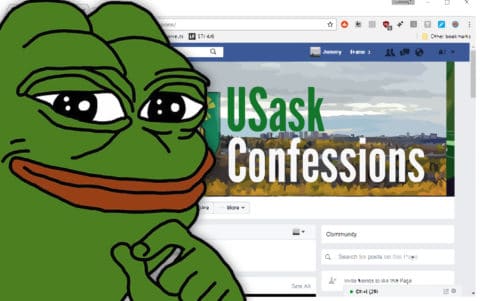With essays, assignments and late term exams keeping students shut off from the rest of the world, when would be better to discuss the one thing that keeps us all interconnected in these troubling times? Of course I speak of the magic power of memes.
Around the University of Saskatchewan, memes have become one of the formative bonds of student culture. Every spring, the U of S Students’ Union elections roll out campaigns aiming to capitalize on the success of the latest memes, meme-inspired turns of phrase are thrown around academic and personal discussions alike, and student social medias are breeding grounds for people to share and tag their friends in Kermit the Frog’s latest moral dilemma.
In my observation, Internet memes still have a slightly unsavoury reputation in some circles. I can understand why — memes from the early 2010s will leave your bones chilled.  Dramatic chipmunks, Viggo Mortensen, bad luck Brians and, of course, crudely drawn reaction faces were painfully unfunny and lacked any analytical depth.
Dramatic chipmunks, Viggo Mortensen, bad luck Brians and, of course, crudely drawn reaction faces were painfully unfunny and lacked any analytical depth.
Cut to 2016 and memes have become so much more than that. While meme templates — such as passing a friend an AUX cord, Joe Biden talking to Barack Obama and, most recently, evil Kermit — are still vital to the meme creation process, there has been such a quantum leap in quality and creativity.
One can barely check social media, receive a phone message or read the news without being barraged ad nauseum with the meme du jour.
Likewise, for today’s student, memes have come to be reflections of our communal heartaches and personal struggles — providing emotional blows that resonate all too much with student demographics and often allowing us to express our inner feelings to others without mustering up the appropriate words ourselves.
For every moment of procrastination, embarrassing performance in a class or encounter with someone who doesn’t like the same music as we do, there’s a meme that speaks profoundly to the experience, helps us to find humour in it and encourages us to share these therapeutic effects with our friends.
Memes are now a modern day art form that exists not on paper, or canvas or film, but on phone screens. With the mass proliferation of smartphones in recent years, the ability to receive, create and share memes has become much more democratized. As a result, the ability to create and share this art amongst friends has never been easier.
Like any good art form, in memes we also find genres and styles blending together to create new fusions out of old parts — a process that has been dubbed “memeception” by Urban Dictionary.
Through memes, a mirror is held up to society that instantaneously shows how we the masses react to currents events, trends and fads.
Essentially, if you think from a 21st century Internet-era approach, memes have become the new political cartoons — single panel images with captions, often somewhat glib or sarcastic, that manage to provide commentary and criticism of current events, politics, pop culture and common emotion.
If there is a takeaway message from all of this, it is simply not to doubt the power and importance of memes. While they may seem like fleeting or disposable entertainment, we can hopefully now understand that nothing is further from the truth.
In memes, we can all naval gaze at the collective experiences of our generation, all while creating important cultural touchstones that will continue to resonate in decades to come.
The holidays are fast approaching and as students, our pocketbooks aren’t always bursting with disposable income to spend on our friends and family. So just remember, it doesn’t cost anything to treat someone to the quaint pleasure of a dank meme.
—
Zach Tennent / Opinions Editor
Graphic: Jeremy Britz / Photo Editor